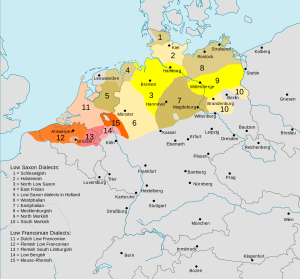By Sarah-Claire Jordan
 Though the national language of the Netherlands is Dutch, that doesn’t mean that it is the only language spoken by the population. English is a very wide-spread language in the country, as well as other languages brought over by immigrants. Despite its small size, one must remember that the Netherlands includes land that was once the home of different warring tribes with their own languages that evolved into the regional languages we see today.
Though the national language of the Netherlands is Dutch, that doesn’t mean that it is the only language spoken by the population. English is a very wide-spread language in the country, as well as other languages brought over by immigrants. Despite its small size, one must remember that the Netherlands includes land that was once the home of different warring tribes with their own languages that evolved into the regional languages we see today.
English is considered a regional language in the Netherlands, but it would be more interesting to take a look at those regional languages that aren’t spoken anywhere else. Here are four of them:
1. Limburgish
Also known as Limburgic and Limburgian, Limburgish is actually a language group that includes different varieties of East Low Franconian. They are spoken in the area known as Limburg as well as Rhineland, along the borders of the Netherlands, Germany, and Belgium. Limburgish has many of the same characteristics as German and Dutch and is sometimes considered to be just a variety of one or the other. However, if you look at how Limburgish has its origins in Old Dutch, you can see that it can’t be considered so closely related to modern Dutch or German.
2. Frisian
Also known as West Frisian, Frisian is one of three Frisian languages, all West Germanic. It is spoken mostly in Friesland, a province in the northern part of the Netherlands. Interestingly enough, it is only called “West Frisian” outside of the Netherlands, to distinguish it from the two other Frisian languages that are spoken in Germany. Around 55% of the population of Friesland are native speakers of Frisian, with over 100,000 people speaking it as a second language. There are some rhymes and other folklore that explore the idea that Frisian and English are closely related.
3. Papiamento
Though not considered a language in the mainland part of the Netherlands, Papiamento is a regional language on the Caribbean island of Bonaire. It is a creole language based on Portuguese and some African and Native American languages, as well as Dutch, English, and Spanish. The exact origins of the language, historically speaking, are not yet known, though there are some hypotheses out there. The influence of Dutch, however, is obvious, as Bonaire was conquered by the Dutch and taken from the Spanish in 1636. The Spanish and English influences also come from Bonaire being under Spanish and later English rule.
4. Dutch Low Saxon
Dutch Low Saxon is a bit of an odd name for the group of West Low German dialects spoken in the northeastern part of the Netherlands, but that is what they have come to be known as today. Some linguists are convinced it is just a dialect of Dutch, but they are looking at the language at only one point in history and looking at its relationship with Dutch at that time. Dutch Low Saxon has carried a stigma of being inferior to other languages for a long time, even being banned in schools at times. It does share a lot with Dutch, and those who speak both can easily switch back and forth between the two.
For an overview of our translation expertise, visit our media and marketing translation page.



